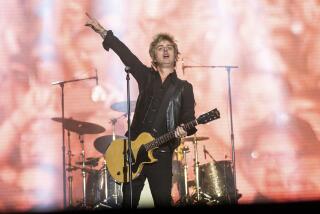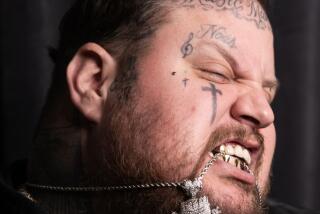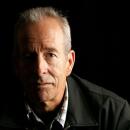Vintage Bruce Springsteen plays Morrison Hotel (in photos); the real deal arrives next week
- Share via
Photographer Joel Bernstein remembers the phone call he received nearly 40 years ago from Bruce Springsteen’s manager, Jon Landau.
He wanted to know what Bernstein thought of the photo used on the cover Springsteen’s 1978 album, “Darkness on the Edge of Town” -- the now-familiar shot of the Boss wearing a white V-neck T-shirt under his black leather jacket, his hair disheveled, a hangdog expression on his face.
“I told him I thought it was a good shot but that I didn’t think it fit the album’s title or the music on that album,” Bernstein said in an interview last week from his Bay Area home. “My feeling is that if your aim is to do photos that might end up on an album cover, you’re trying to make it a visual manifestation of the music inside.”
See more of Entertainment’s top stories on Facebook >>
Bernstein had a pretty solid track record of coming up with iconic album cover photos before that, having snapped the mercurial shot of Neil Young walking down a New York street that Young selected for the cover of his 1970 solo album, “After the Gold Rush,” an image Bernstein took shortly after he graduated from high school.
Landau subsequently invited him to shoot Springsteen for images that might be used for his next album, which eventually would turn into “The River,” but not before some major changes in the original vision for the successor to “Darkness.”
Bernstein’s photos shot during that period will be on exhibit beginning Thursday at the Morrison Hotel Gallery in West Hollywood, along with those of David Gahr, Frank Stefanko, Jim Marchese, Lynn Goldsmith, Neal Preston and Patrick Harbron in “The River Collection” show.
All seven photographers shot Springsteen in the late 1970s and early 1980s as his career was continuing to expand in leaps and bounds. The show includes album cover art and shots that appeared on LP sleeves, as well as casual shots not previously exhibited and a good number of concert photos from the period.
“The River Collection” exhibition ran for several weeks at the Morrison Hotel Gallery in New York City and is moving west, timed to open a few days before Springsteen and the E Street Band return to Los Angeles for three nights of shows March 15, 17 and 19 that will be the swan song for the Los Angeles Sports Arena, which will be razed to make way for a new soccer stadium.
Among the images in the exhibition are Stefanko’s shot that Springsteen chose for the cover of “The River,” the 1981 double album that replaced “The Ties That Bind,” a single album he assembled, submitted to Columbia Records and then withdrew after having second thoughts about it.
As Stefanko pointed out in a separate interview, “The secret is that a lot of ‘The River’ and ‘Darkness’ photographs were really taken at the same time in 1978.
“It was a very important time for him,” said Stefanko, who had been an early fan of Springsteen’s music because he also lived in New Jersey, where Springsteen had been a local hero before breaking nationally.
“He had a change of management and gone with Jon Landau; there was a lot of litigation involved, and he’d had a three-year layoff from putting out new music, which in rock ‘n’ roll could be deadly. So he took a lot of time with what came next, including the photography. He had a lot of people shoot for the ‘Darkness’ album as well as for ‘The River.’”
One revelation the show, which runs through March 20, may have for Springsteen fans is the color version of the original photo that landed on “The River” cover.
“You’ll notice in the color print it’s not a black-and-white shirt, they way it looks on the album,” Stefanko said. “It’s actually kind of pinkish and white.”
Stefanko and Bernstein were struck by the focus Springsteen brought to the music he was making and his vision of how he wanted it to be different than what had preceded it.
“This was a much more mature album than his previous albums with all their songs about cars and girls,” Stefanko said. “It was about working-class people, people seeking redemption, people just trying to make their way through the world. It was about people who do what they have to do to put bread on the table — so many different themes, but much more mature themes.”
Bernstein also found himself intrigued by Springsteen’s lifestyle at the time.
“I was stuck by fact that he lived in a large house by himself,” he said. “I don’t know what was going on in his personal life at that time. Unlike Frank, who had known him for years and who would have known what was going on, I’m coming across the country from California and dropping into that world. I was struck by fact that he preferred to live by himself.
“Also, he had a Ford pickup truck he drove around in,” he said. “It had Bondo on the side — it was a $200 truck. He could have had any vehicle he wanted. After working for Neil Young and his 50 vehicles, I found it kind of an interesting contrast.”
The photographers whose work is in “The River collection” have recently revisited their archives for images that Springsteen and his record label culled for “The Ties That Band: The River Collection” multi-disc box set that was released in December.
Several of them continued to shoot for Springsteen after “The River” was originally released, assignments that highlighted the way the music business and rock ‘n’ roll photography have changed over time.
“Things are very different now,” Bernstein said. “I’m very grateful I got to spend so much time with him. I didn’t realize at the time what a luxury it was to spend a few days with him and hang out with the band. If you do that, you can get to the point where you disappear. They’re used to you just walking around with them, and now and then you lift the camera and get a shot, and that’s when you can capture the more off-guard moments.
“Now it’s more like, ‘OK, Joel Bernstein is coming over and you’ve got 20 minutes to do some publicity shots for the EPK [electronic press kit],” he said. “Back then, you were able to get things that nowadays I think would be harder because of the demands on somebody as well known as he was then. Good luck getting that amount of time with somebody like that today.”
Follow @RandyLewis2 on Twitter. For more on Classic Rock, join us on Facebook.
More to Read
The biggest entertainment stories
Get our big stories about Hollywood, film, television, music, arts, culture and more right in your inbox as soon as they publish.
You may occasionally receive promotional content from the Los Angeles Times.











